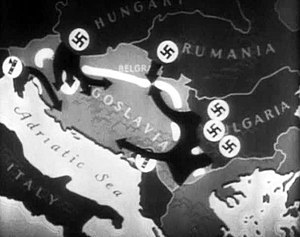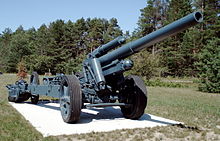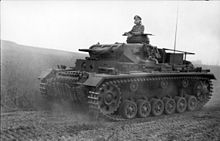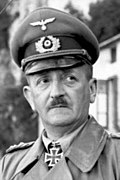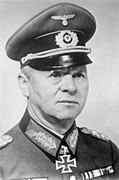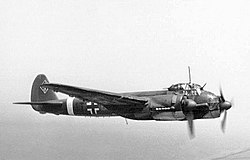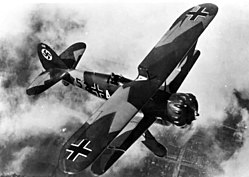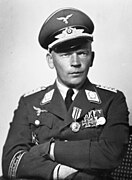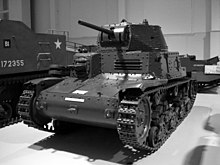Operation Husky order of battle is a listing of the significant military and air force units that were involved in the campaign for Sicily, July 10 – August 17, 1943.

A Panzer division was one of the armored (tank) divisions in the army of Nazi Germany during World War II. Panzer divisions were the key element of German success in the blitzkrieg operations of the early years of World War II. Later the Waffen-SS formed its own panzer divisions, and the Luftwaffe fielded an elite panzer division: the Hermann Göring Division.
The 1st Army was a Royal Yugoslav Army formation commanded by Armijski đeneral Milan Rađenković during the German-led Axis invasion of the Kingdom of Yugoslavia in April 1941 during World War II. It consisted of one infantry division, one horsed cavalry division, and two brigade-strength infantry detachments. It formed part of the 2nd Army Group, and was responsible for the defence of the section of the Yugoslav-Hungarian border between the Danube and the Tisza rivers.

The invasion of Yugoslavia, also known as the April War or Operation 25, was a German-led attack on the Kingdom of Yugoslavia by the Axis powers which began on 6 April 1941 during World War II. The order for the invasion was put forward in "Führer Directive No. 25", which Adolf Hitler issued on 27 March 1941, following a Yugoslav coup d'état that overthrew the pro-Axis government.
The Battle of Hannut was a Second World War battle fought during the Battle of Belgium which took place between 12 and 14 May 1940 at Hannut in Belgium. It was the largest tank battle in the campaign. It was also the largest clash of tanks in armoured warfare history at the time.

The Italian invasion of Egypt was an offensive in the Second World War from Italian Libya, against British, Commonwealth and Free French in the neutral Kingdom of Egypt. The invasion by the Italian 10th Army ended border skirmishing on the frontier and began the Western Desert Campaign (1940–1943) proper. The Italian strategy was to advance from Libya along the Egyptian coast to seize the Suez Canal. After numerous delays, the scope of the offensive was reduced to an advance as far as Sidi Barrani and the defeat of any British forces in the area.
The 101st Jäger Division was a light infantry Division of the German Army in World War II. It was formed in July 1942 by the redesignation of the 101st (Light) Infantry Division, which was itself formed in December 1940. The Walloon Legion was briefly attached to this division from December 1941 to January 1942. The Division took part in the Battle of Kharkov, the Battle of the Caucasus, and the retreat into the Kuban, where it suffered heavy losses fighting both the Red Army and partisans. The division was then involved in the battles in the Kuban bridgehead before being evacuated. The 101st was subsequently transferred to the lower Dnieper River in late 1943. It was part of the 1st Panzer Army that was surrounded in March 1944; it formed the rear guard for the XLVI Panzer Corps during the breakout of the Kamenets-Podolsky pocket. The division then retreated across Ukraine. In October 1944, it was moved to Slovakia and took part in the Battle of the Dukla Pass.
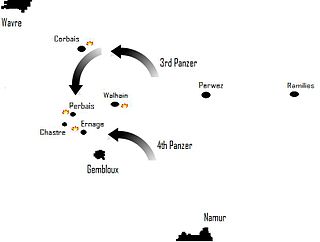
The Battle of Gembloux was fought between French and German forces in May 1940 during the Second World War. On 10 May 1940, The Nazi Wehrmacht, invaded Luxembourg, The Netherlands and Belgium under the operational plan Fall Gelb. Allied armies responded with the Dyle Plan, intended to halt the Germans in Belgium, believing it to be the main German thrust. The Allies committed their best and most mobile to an advance into Belgium on 10 May and on 12 May, the Germans began the second part of Fall Gelb, the Manstein Plan an advance through the Ardennes, to reach the English Channel and cut off the Allied forces in Belgium.
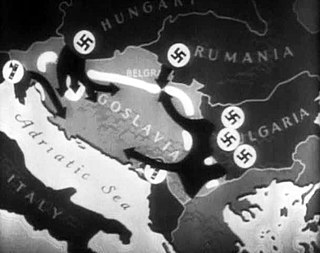
The Yugoslav order of battle before the invasion of Yugoslavia includes a listing of all operational formations of the Royal Yugoslav Army, Royal Yugoslav Army Air Force and Royal Yugoslav Navy immediately prior to the World War II invasion of that country in April 1941.
The 1st Army Group was a Royal Yugoslav Army formation mobilised prior to the German-led Axis invasion of Yugoslavia in April 1941 during World War II. It consisted of the 4th Army, 7th Army, and the 1st Cavalry Division, which was the army group reserve. It was responsible for the defence of northwestern Yugoslavia, with the 4th Army defending the eastern sector along the Yugoslav–Hungarian border, and the 7th Army defending the western sector along the borders with Germany and Italy. Like all Yugoslav formations at the time, the 1st Army Group had serious deficiencies in both mobility and firepower as well as internal friction among the different ethnic groups, particularly between Serbs and Croats.
The 2nd Army Group was a Royal Yugoslav Army formation commanded by Armijski đeneral Milutin Nedić during the German-led Axis invasion of the Kingdom of Yugoslavia in April 1941 during World War II. It consisted of the 1st and 2nd Armies, comprising four infantry divisions, one horsed cavalry division, two brigade-strength infantry detachments, and one horsed cavalry regiment. It was responsible for the defence of the border with Hungary from Slatina to the Tisza river.

The 2nd Army was a Royal Yugoslav Army formation commanded by Armijski đeneral Dragoslav Miljković that opposed the German-led Axis invasion of the Kingdom of Yugoslavia in April 1941 during World War II. It consisted of three infantry divisions and one horsed cavalry regiment along with supporting units. It formed part of the 2nd Army Group, and was responsible for the defence of the Yugoslav–Hungarian border along the Drava river from Slatina to the Danube.

The 4th Army was a Royal Yugoslav Army formation mobilised prior to the German-led Axis invasion of the Kingdom of Yugoslavia during World War II. It was drawn from the peacetime 4th Army District. When mobilised, it consisted of three divisions, a brigade-strength detachment, one horse cavalry regiment and one independent infantry regiment. It formed part of the 1st Army Group, and was responsible for defending a large section of the Yugoslav–Hungarian border, being deployed behind the Drava river between Varaždin and Slatina. Like all Yugoslav formations at the time, the 4th Army had serious deficiencies in both mobility and firepower.
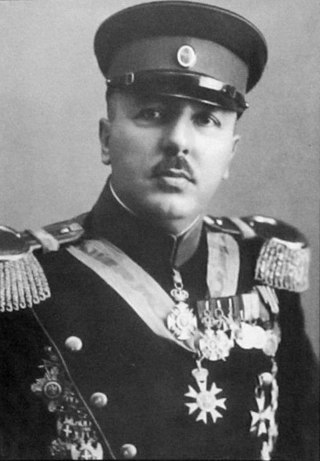
The 7th Army was a Royal Yugoslav Army formation raised prior to the German-led Axis invasion of Yugoslavia in April 1941, during World War II. It consisted of two divisions, two brigade-strength mountain detachments, and a brigade-strength infantry detachment. It formed part of the 1st Army Group, and was responsible for the defence of Yugoslavia's north-western frontier with Italy and Germany. Like all Yugoslav formations at the time, the 7th Army had serious deficiencies in both mobility and firepower.
The 42nd Infantry Division Murska was an infantry formation of the Royal Yugoslav Army that formed part of the 4th Army during the German-led Axis invasion of the Kingdom of Yugoslavia in April 1941. It did not have a corresponding divisional district in peacetime, and was raised at the time of mobilisation. Like all Yugoslav infantry divisions of the time, it was a very large and unwieldy formation which was almost entirely reliant on animal transport for mobility, and also lacked modern arms and sufficient ammunition. Commanded by Divizijski đeneral Borisav Ristić, it was largely manned by Croat troops, many of whom saw the Germans as potential liberators from Serbian oppression.
The 40th Infantry Division Slavonska was an infantry formation of the Royal Yugoslav Army that formed part of the 4th Army during the German-led Axis invasion of the Kingdom of Yugoslavia in April 1941. It was partly mobilised from the Osječka military district, and, like all Yugoslav infantry divisions of the time, was a very large and unwieldy formation which was almost entirely reliant on animal transport for mobility. Commanded by Brigadni đeneral Ratko Raketić, it was largely manned by Croat troops, many of whom saw the Germans as potential liberators from Serbian oppression during the interwar period, and the division also lacked modern arms and sufficient ammunition.
The 27th Infantry Division Savska was an infantry formation of the Royal Yugoslav Army that formed part of the 4th Army during the German-led invasion of Yugoslavia by the Axis powers in April 1941. It was raised from the Savska divisional district, and like all Yugoslav infantry divisions of the time, was a very large and unwieldy formation almost entirely reliant on animal transport for mobility. Commanded by Divizijski đeneral August Marić, the division was largely made up of ethnic Croat troops, many of whom saw the Germans as potential liberators from Serbian oppression during the interwar period. It also lacked modern arms and sufficient ammunition.

The 32nd Infantry Division Triglavski was a short-lived Royal Yugoslav Army infantry formation raised prior to the German-led Axis invasion of the Kingdom of Yugoslavia in April 1941. It was largely mobilised from the Dravska military district, and, like all Yugoslav infantry divisions of the time, was a very large and unwieldy formation which was almost entirely reliant on animal transport for mobility. Commanded by Divizijski đeneral Dragiša Pandurović and largely manned by Slovene troops, the division also lacked modern arms and sufficient ammunition.

The 1st Cavalry Division of the Royal Yugoslav Army was established in 1921, soon after the creation of the Kingdom of Serbs, Croats and Slovenes, which became the Kingdom of Yugoslavia in 1929. In peacetime it consisted of two cavalry brigade headquarters commanding a total of four regiments. It was part of the Yugoslav 1st Army Group during the German-led World War II Axis invasion of Yugoslavia in April 1941, with a wartime organisation specifying one cavalry brigade headquarters commanding two or three regiments, and divisional-level combat and support units.
The 38th Infantry Division Dravska was a short-lived Royal Yugoslav Army infantry formation raised prior to the German-led Axis invasion of the Kingdom of Yugoslavia in April 1941. It was largely mobilised from the Dravska divisional district, and, like all Yugoslav infantry divisions of the time, was a very large and unwieldy formation which was almost entirely reliant on animal transport for mobility. Commanded by Divizijski đeneral Čedomir Stanojlović and largely manned by Slovene and ethnic German troops, the division also lacked modern arms and sufficient ammunition to meet the German onslaught.
